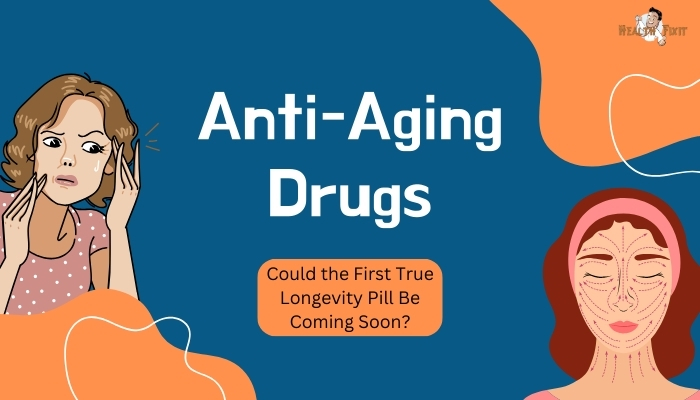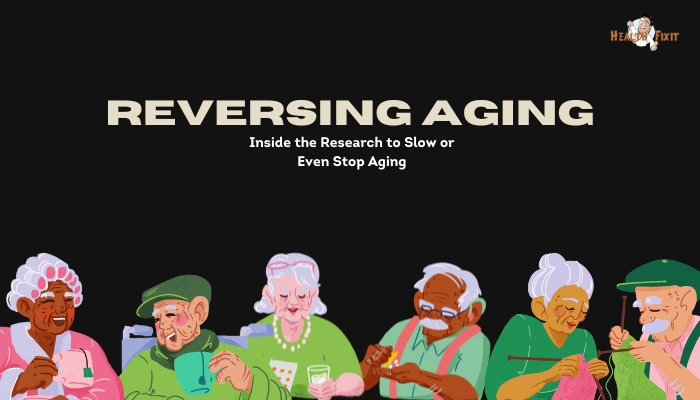Introduction
For centuries, people have imagined potions or elixirs that stave off old age. Today, modern science is testing compounds that might slow age-related processes in the body and push back the onset of chronic diseases.
Researchers around the globe investigate how molecular hallmarks of aging—such as senescent cell buildup or altered nutrient-sensing pathways—could be targeted by drug therapies.
While some medications already exist for other conditions, they are now being studied for potential “longevity pill” effects.
This article dives into the leading anti-aging drug candidates, outlines their biological mechanisms, and reviews the status of clinical trials.
It also addresses the ethical and practical questions surrounding a future in which doctors may prescribe one or more “anti-aging” drugs.
If these medications can truly extend healthy lifespan, they will likely reshape medical practice and transform how society views aging.
The Case for Anti-Aging Drugs
Age remains the biggest risk factor for conditions like cardiovascular disease, cancer, type 2 diabetes, and neurodegenerative disorders. Instead of treating each ailment separately, scientists envision therapies that target shared aging mechanisms, thereby preventing multiple disorders at once. This paradigm shift in medical research has propelled efforts to test “geroprotectors,” i.e., drugs that slow or modify aging biology.
Hallmarks of Aging
Current anti-aging research often focuses on a framework known as the “Hallmarks of Aging,” which include:
- Genomic instability
- Telomere attrition
- Epigenetic alterations
- Loss of proteostasis
- Deregulated nutrient sensing
- Mitochondrial dysfunction
- Cellular senescence
- Stem cell exhaustion
- Altered intercellular communication
Potential anti-aging drugs aim to correct or counteract these processes—whether by cleaning up damage, increasing the body’s repair capacity, or boosting cellular housekeeping functions. The hope is that postponing these detrimental changes will keep people healthier for longer, delaying or preventing the onset of age-related diseases.
Rapamycin: Targeting mTOR
Rapamycin, discovered on Easter Island (Rapa Nui), was initially developed as an immunosuppressant. In subsequent decades, researchers discovered that rapamycin inhibits mTOR (mechanistic target of rapamycin), a key protein kinase that senses nutrient availability. In animal models—from worms to mice—dampening mTOR activity has extended lifespan and delayed age-associated functional decline.
How Rapamycin Works
- Reduced Protein Synthesis: mTOR boosts cell growth and protein production. Slowing it prompts cells to devote more energy to maintenance.
- Enhanced Autophagy: Autophagy is a cleanup process. With mTOR reined in, cells more actively degrade damaged proteins and organelles.
- Stress Resistance: Rapamycin can increase the body’s ability to handle oxidative and metabolic stress.
Clinical Trials and Challenges
- Immunosuppressive Effects: High doses of rapamycin can weaken immune responses, increasing infection risk.
- Intermittent Dosing: Researchers explore lower or intermittent doses to minimize side effects.
- Human Studies: Some small trials in older adults tested rapamycin or “rapalogs” (rapamycin analogs). Results show improvements in certain immune parameters, but long-term safety and efficacy must be clarified.
If mTOR inhibitors can be delivered safely, they might become the first drugs specifically approved to improve aging-related outcomes. Ongoing research and multi-year human trials are key to determining whether rapamycin can deliver consistent, practical benefits for longevity.
Metformin: The Diabetes Drug with Longevity Potential
Metformin has been a standard treatment for type 2 diabetes for decades. Observational studies revealed that diabetic patients on metformin sometimes outlive non-diabetic individuals, prompting speculation that metformin has “anti-aging” properties.
Mechanisms of Action
- AMPK Activation: Metformin triggers AMPK, an energy sensor that drives metabolic adjustments when cellular energy is low.
- Reduced Glucose Production: Metformin lowers liver gluconeogenesis, moderating blood sugar levels.
- Less Oxidative Stress: By optimizing mitochondrial function, metformin can help reduce free-radical generation.
- Improved Insulin Sensitivity: Chronic inflammation linked to insulin resistance is a hallmark of aging. Improving sensitivity may curb systemic inflammation.
The TAME Trial
- Targeting Aging with Metformin (TAME) is a large-scale clinical trial examining whether metformin delays the onset of multiple age-related disorders—heart disease, cognitive impairment, and cancer—in older, non-diabetic adults.
- Endpoints: Researchers measure disease-free survival, functional status, and biomarkers of aging.
- Implications: If TAME proves successful, metformin could become an affordable, widely available longevity drug.
Though metformin is well-known and relatively safe, no formal regulatory pathway currently exists for “anti-aging” drug approvals. TAME’s outcomes may guide future policy decisions about prescribing a medication primarily to stave off age-related decline.
Senolytics: Clearing “Zombie” Cells
As the body ages, it accumulates senescent cells—old, damaged cells that stop dividing but remain metabolically active. These so-called “zombie” cells secrete inflammatory signals and degrade tissue function, a phenomenon called the senescence-associated secretory phenotype (SASP). Drugs known as senolytics target and kill senescent cells to reduce systemic inflammation.
Key Senolytic Agents
- Dasatinib + Quercetin: This drug-flavonoid combination was among the first to show senolytic activity in rodents.
- Fisetin: A plant polyphenol found in fruits like strawberries. Some preclinical data suggest it selectively removes senescent cells.
- Navitoclax: A BCL-2 inhibitor initially tested for cancer, it may also help remove senescent cells.
Current Clinical Research
Early trials investigate whether senolytics can ease conditions such as osteoarthritis or lung fibrosis in older adults. By eliminating senescent cells, scientists hope to lower inflammation, enhance tissue regeneration, and improve overall health. However, the risk profile and dosing schedules remain under review. If side effects prove manageable, senolytics might be used intermittently (e.g., monthly “hits”) rather than daily, possibly reducing adverse events while retaining benefits.
NAD+ Boosters: Fueling Cellular Energy
Nicotinamide adenine dinucleotide (NAD+) is crucial for cellular metabolism and DNA repair. Its levels decline with age, impairing mitochondria and essential enzymes like sirtuins that regulate healthspan. Supplements that raise NAD+—including nicotinamide riboside (NR) and nicotinamide mononucleotide (NMN)—are widely available commercially and undergo active clinical research.
How NAD+ Affects Aging
- Energy Production: NAD+ is vital for ATP generation in mitochondria.
- Sirtuin Activation: Sirtuins depend on NAD+ to regulate gene expression and repair damage.
- Improved Metabolic Health: Restoring NAD+ may help mitigate insulin resistance and reduce some inflammation markers.
Evidence and Trials
- Animal Studies: Replenishing NAD+ improved muscle function, endurance, and certain cognitive parameters in old mice.
- Human Data: Small pilot trials find that NR or NMN supplementation can raise NAD+ levels in blood. Some participants showed slight improvements in metabolic markers.
- Unanswered Questions: Efficacy for true longevity or disease prevention remains unclear. Longer, larger trials are needed to confirm whether NAD+ boosters significantly slow aging.
Combining Therapies for Better Results
Aging arises from intertwined pathways—genomic instability, senescence, mitochondrial problems, and more. A single intervention might help but likely won’t address all aspects of aging. Researchers hypothesize that multi-pronged regimens may yield the most robust protection. Examples include:
- Metformin + Rapamycin: Targeting two major nutrient-sensing pathways (AMPK and mTOR) simultaneously might reinforce metabolic resilience.
- NAD+ Boosters + Senolytics: Elevating cellular energy while clearing inflammatory senescent cells could reestablish a healthier tissue environment.
- Lifestyle + Pharmacological: Drugs can complement the foundational impact of diet, exercise, and stress management.
Still, combining potent drugs requires careful trial design and regulatory oversight. Researchers must ensure that synergy does not produce harmful side effects, and that multi-drug regimens remain practical for everyday use.
Ethical and Practical Considerations
Access and Equity
If an “anti-aging” pill is developed, it may be expensive initially, creating inequities in who reaps its benefits. Policymakers and payers will need strategies to ensure wide availability if the drug safely extends healthspan or delays disease.
Regulatory Pathways
Most health agencies lack an official “aging” label for drug approval. Instead, clinical trials measure disease outcomes like cardiovascular events, cancer rates, or cognitive decline. If a drug lowers the risk of many diseases by addressing aging processes, regulators must adapt or create frameworks for evaluating such multi-disease endpoints.
Overpopulation and Resource Use
Longer, healthier lives might influence retirement ages, healthcare costs, and resource consumption. Some worry that life-extending drugs could add to population pressures, though improved health might also enable extended workforce participation and economic contributions. Addressing these complexities will require careful public health planning.
Current Clinical Trials and Future Outlook
Most anti-aging drug trials to date have been small or have studied biomarkers and risk factors, rather than direct measures of lifespan extension. Larger, more definitive studies are underway. Examples include:
- TAME (Metformin): Testing whether metformin delays common age-related diseases in older adults.
- Senolytic Trials: Investigating improvement in osteoarthritis, lung function, and frailty with periodic senolytic dosing.
- Rapamycin Analogs: Evaluating immune function and metabolic health in seniors.
- NAD+ Precursor Studies: Measuring changes in muscle strength, metabolic markers, and inflammation with NR or NMN supplementation.
If results prove that these therapies meaningfully reduce disease incidence and prolong healthy years, we may witness a shift from treating individual age-related conditions to prescribing broad “anti-aging” medications. The key is whether trials can confirm safety and the ability to extend the healthspan—delaying not just one illness, but a suite of them.
Practical Steps Before “Longevity Pills” Arrive
Even if an approved anti-aging drug becomes available, healthy lifestyle choices will likely remain essential. Factors like diet, exercise, and stress management are low-cost strategies that reinforce any pharmacological therapy. For now:
- Regular Checkups: Early detection of hypertension, dyslipidemia, or prediabetes reduces long-term complications.
- Weight Management: Maintaining a healthy body weight lowers insulin resistance and chronic inflammation.
- Stay Active: Even moderate physical activity helps preserve muscle mass, bone density, and metabolic function.
- Balanced Diet: Nutrient-dense foods support energy balance, reduce oxidative stress, and fuel repair processes.
- Manage Stress and Sleep: Chronic stress hormones accelerate aging biology, while good sleep supports tissue repair.
These measures may complement future anti-aging drugs, optimizing overall health and potentially enhancing drug effectiveness once such treatments become mainstream.
Conclusion
The concept of an “anti-aging pill” once seemed confined to folklore. However, emerging research on rapamycin, metformin, senolytics, NAD+ boosters, and combination strategies shows genuine potential for slowing—or partially reversing—fundamental aging processes.
Ongoing clinical trials will determine whether these interventions can meaningfully reduce the burden of age-related diseases in humans.
Any breakthrough will introduce new ethical, economic, and regulatory challenges, ranging from access inequities to the question of how to measure “aging” as a medical endpoint.
Nonetheless, the global push to translate laboratory findings into practical longevity treatments continues to gather momentum.
If successful, the first true anti-aging drugs might redefine healthcare for older adults, allowing people to lead longer, healthier lives free from chronic illness.
The coming years and ongoing trial results will reveal whether the dream of a longevity pill can become reality.
References
- López-Otín C, Blasco MA, Partridge L, Serrano M, Kroemer G. The hallmarks of aging. Cell. 2013;153(6):1194–1217.
- Mannick JB, Del Giudice G, Lattanzi V, et al. mTOR inhibition improves immune function in the elderly. Sci Transl Med. 2014;6(268):268ra179.
- Barzilai N, Crandall JP, Kritchevsky SB, Espeland MA. Metformin as a tool to target aging. Cell Metab. 2016;23(6):1060–1065.
- Justice JN, Nambiar AM, Tchkonia T, et al. Senolytics in idiopathic pulmonary fibrosis: Results from a first-in-human, open-label, pilot study. EBioMedicine. 2019;40:554–563.
- Sinclair DA, LaPlante MD. Lifespan: Why We Age—and Why We Don’t Have To. Atria Books; 2019.
- Epel ES. The geroscience agenda: Toxic stress, hormetic stress, and telomere damage. Health Psychol. 2020;39(10):828–834.
- Birnbaum KD. NAD+ in aging and disease. Trends Cell Biol. 2021;31(6):409–422.
- Kirkland JL, Tchkonia T. Senolytic drugs: From discovery to translation. J Intern Med. 2020;288(5):518–536.
- Espeland MA, Kritchevsky SB, Barzilai N, et al. The effects of metformin on aging: The TAME trial. Cells. 2022;11(14):2236.
- Tchkonia T, Palmer AK, Kirkland JL. New directions in cellular senescence and senolytics. Annu Rev Med. 2021;72:1–15.





